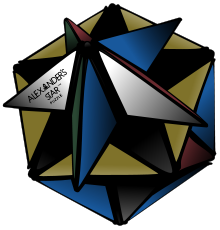Alexander Star
 |
|
| Type | Puzzle |
|---|---|
| Inventor | Adam Alexander |
| Company | Ideal Toy Company |
| Country | United States |
| Availability | 1982–present |
Alexander's Star is a puzzle similar to the Rubik's Cube, in the shape of a great dodecahedron.
Alexander's Star was invented by Adam Alexander, an American mathematician, in 1982. It was patented on 26 March 1985, with US patent number 4,506,891, and sold by the Ideal Toy Company. It came in two varieties: painted surfaces or stickers. Since the design of the puzzle practically forces the stickers to peel with continual use, the painted variety is likely a later edition.
The puzzle has 30 moving pieces, which rotate in star-shaped groups of five around its outermost vertices. The purpose of the puzzle is to rearrange the moving pieces so that each star is surrounded by five faces of the same color, and opposite stars are surrounded by the same color. This is equivalent to solving just the edges of a six-color Megaminx. This is an odd puzzle to solve, and never really looks complete unless you know what you're looking for. The puzzle is solved when each pair of parallel planes is made up of only one colour. To see a plane, however, you have to look "past" the five pieces on top of it, all of which could/should have different colours than the plane you're solving.
If considering the pentagonal regions as faces, like in the great dodecahedron represented by Schläfli symbol {5,5/2}, then the requirement is for all faces to be monochrome and for opposite faces to share the same color.
There are 30 edges, each of which can be flipped into two positions, giving a theoretical maximum of 30!×230 permutations. This value is not reached for the following reasons:
This gives a total of possible combinations.
...
Wikipedia

